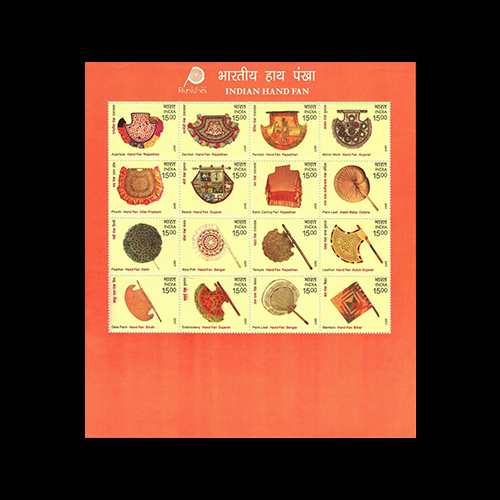Fascinating Archaeological Facts on Postage Stamps - 79
2025-07-31 Thu
The tropical and humid climate of India has historically prompted the development of innovative cooling methods. One of the effective methods, still used by Indians is fanning. Traditional fanning techniques in India were closely associated with the natural materials available, including palm leaves, peacock feathers, bamboo, and a variety of textiles.The origins of hand Fans can be traced back nearly 4,000 years to ancient Egypt, where two elaborate fans were discovered in the tomb of King Tutankhamun. However, the folding hand fan is believed to have been invented in either Japan or China, with both nations claiming a rich Cultural Heritage regarding its creation.
In the context of Indian History, the earliest references to fans can be found in the EPIC Ramayana, which describes fly whisks known as chouries, chauries, or chamaras. These instruments were employed by attendants to fan deities in #temples as well as nobility at court.
Despite the absence of physical evidence of hand fans, their presence has been documented in numerous sculptures and paintings throughout ancient periods. A notable example is the Didarganj YAKSHI, currently housed in the Bihar Museum, which is depicted as a chauri bearer. Further insights into the Didarganj Yakshi can be found at https://x.com/MintageWorld/status/1927983721266958387.
The chauri, made of long, flowing fibers attached to a handle, is symbolizes authority and reverence, often featured in religious and Royal iconography. During the Gupta period, the chauri was depicted on coins as well. The Ashvamedha type of coins of Samudragupta portrays a standing queen facing left and holding a chauri.
Furthermore, hand fans crafted from palm leaves were also prevalent in ancient India, as evidenced by terracotta sculptures from the Shunga period. The term "punkha" or "pankha" is derived from the Sanskrit word "paksha," meaning WINGS." In this context, pankha refers to all types of fans, while the term "pankhi" denotes a smaller, plumed fan used in ancient India. Evidence of the pankhi's existence can be observed in Buddhist wall paintings at ajanta.
In contemporary times, the demand for hand-operated fans has diminished. However, in certain rural areas of India, hand fans have persisted as traditional crafts. Notably, on 30 Dec 2017, India post issued a set of 16 Stamps and three miniature sheets featuring various styles of Indian hand fans. These stamps showcase fans from different states, including the Applique Hand Fan and Zardozi Hand Fan from Rajasthan, Mirror Work Hand Fan and Beads Hand Fan from Gujarat, Sola Pith Hand Fan and Palm Leaf Hand Fan from West #bengal , and #Bamboo Hand Fan from Bihar, etc.
Latest News
-
Ghiyath Shah as Heir Apparent
2025-09-25 ThuGhiyath Shah was the ruler of the Malwa Sultanate, reigning from 1456 to 1500. From 1456 to 1469, he...
-
Malwa Sultan Mahmud Shah Silver Coins
2025-09-11 ThuMalwa Sultan Mahmud Shah minted silver coins in round and square flans. <br><br> For round coins,...
-
Malwa Sultan Mahmud Shah Billon coin
2025-08-26 TueMalwa Sultan Mahmud Shah's billon coins followed three weight standards: 100 rati, 96 rati, and 80 r...
-
Fascinating Archaeological Facts on Postage Stamps - 91
2025-08-23 SatRhinoceros is one of the oldest land mammal species existing in India. There are five species of rhi...
-
Fascinating Archaeological Facts on Postage Stamps - 90
2025-08-23 SatUthiramerur, a Village in Kanchipuram, Tamil Nadu, is notable for its Temple inscriptions that descr...

